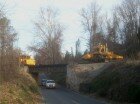Hot spot: Is your house wildfire safe?
 While the state-wide burn ban lifted yesterday by Governor Tim M. Kaine was certainly prompted by the non-stop video coverage of the California wildfires, the Governor explained that it was being imposed because of the severe drought conditions throughout Virginia. During yesterday’s announcement, Kaine said there could have been as many as 1,500 wildfires had the ban not been imposed.
While the state-wide burn ban lifted yesterday by Governor Tim M. Kaine was certainly prompted by the non-stop video coverage of the California wildfires, the Governor explained that it was being imposed because of the severe drought conditions throughout Virginia. During yesterday’s announcement, Kaine said there could have been as many as 1,500 wildfires had the ban not been imposed.
While wildfires in Virginia may not be as common or as voracious as they are in Southern California, John Campbell (photo left), an information officer with the Virginia Department of Forestry, says they are still a genuine risk to homeowners in Virginia.
“We may not live in California, but we are still at risk, especially after the drought we’ve had,” says Campbell.
Indeed, according to Virginia Department of Forestry data, drought conditions in years past have caused far more than 1,500 wildfires.
In 1930, there were 2,554 wildfires that burned 333,023 acres. In 1952 2,494 fires burned 111,571 acres. In 1995, dry conditions prompted the evacuation of 65 residents in Franklin County, where 150 acres of forest burned, and on April 2, 1999, a fire fueled by drought conditions burned 400 acres on Afton Mountain. During the severe 2001 drought, FEMA and fire fighting crews from Florida stepped in to battle 2,232 wildfires that burned 19,476 acres. In 2006, Virginia experienced 788 wildfires that burned 5,278 acres during the first 87 days of the year, more than the entire year total of 773 fires and 4,859 acres for 2005.
As a result of the burn ban, and because of the massive fire consuming California, Campbell says that Virginia homeowners have expressed more concern about protecting their homes.
The following is a forthcoming Hook Gimme Shelter column by Mr. Campbell on protecting your home against wildfire:
Hot spot: Is your house wildfire safe?
During wildfire outbreaks, when hundreds of houses are at risk, local fire departments can be seriously understaffed. As a result, whether your home survives or firefighters can get to it depends on how it’s situated on your land. The area 30 feet around your house (if you have outbuildings, it should be 30 feet beyond those) is critical– what we refer to as the Home Defensible Zone (HDZ).
First, look at your trees. If you have a lot of evergreens, maintain a 10-foot minimum space between other trees. This distance will keep the fire from jumping between trees. Be sure to maintain this distance from trees to the house. Keep in mind: you may need to remove a few.
Is there tall grass, or are there leaves, or low-lying branches around the house? This is called “ladder fuel” because it provides a “ladder” for fire to climb from the ground to trees. Eliminate this by keeping grass watered and mowed short on all sides of all buildings, trimming shrubs, and pruning the lower branches of trees up six to ten feet.
Do you have a pile of firewood against the house? You may want to put it outside the HDZ zone, as sparks from a wildfire can easily catch in firewood piles, and the intense heat can quickly ignite the house.
You’ll also want to clean up leaf and needle fall that accumulates under foundation plantings, next to buildings, and under decks. Take special care to clean dead leaves from under trees (especially evergreens) next to buildings.
Consider using rock and stone landscaping materials next to buildings.
Clear a 10-foot space around propane tanks and keep it covered in gravel, rock or short, well-watered grass. And remember: propane tanks should be located at least 10 feet from the house.
Store gasoline, oily rags, and other flammable materials in approved safety cans. Keep those safety cans in a fire-resistant metal or brick building or your garage.
Are there any branches close to power lines on your property? Ask the power company to clear them.
Make sure motorized garden equipment, such as lawnmowers and chainsaws, have approved and functioning spark arrestors.
The home front
Of course, modifications to a house can be expensive, such as re-siding with brick, stone, stucco or steel, replacing shake roofing with shingles or steel, or enclosing foundations with steel or masonry. But it’s worth considering if you’re planning to rebuild or remodel. We also recommend enclosing foundations, outbuildings, and trailers, plus decks and overhangs with solid flame-resistant sheeting to keep sparks from igniting materials underneath.
Does your fireplace chimney have an effective spark arrestor? A wayward spark is all it takes in dry weather. Inspect your chimney annually for cracks in the brick and liner, and clean your fireplace and wood stove chimneys at least twice a year.
Clean leaves and needles off the roof and from windowsills.
Make sure your soffits are enclosed with a solid barrier and that vents are screened with a fine mesh to keep out flying embers.
Believe it or not, radiant heat from a large wildfire can actually ignite sheer curtains inside a house through large glass windows. Consider shutters for large windows.
Ways to burn
If you burn leaves and debris, consider alternatives like composting.
Make sure recreational fires are in a fire-safe pit or container and completely extinguished before you leave the premises. Before lighting any outdoor fire, check for local restrictions and permit requirements. Avoid lighting fires in high winds, or when high temperatures and low humidity is present or predicted.
Wear a name tag
Finally, remember that firefighters can’t save a house if they can’t find it or get to it. Make sure your address is clearly visible from the road. Also, without a clearly visible address, good access, and an escape route, firefighters will not likely endanger themselves to save a house.
If your driveway is less than 150 feet long, firefighters will be able to reach the house from the street. But if your driveway is over 150 feet long, make sure there’s a large turnaround near the house. The turnaround radius should be at least 30 feet.
Your driveway should also be at least 12 feet wide and be clear of branches 14 feet up. Longer driveways need to be 20 feet wide. The driveway should also have a firm, all-weather surface, and any bridges or culverts should be rated to 10,000 pounds. Curves in long driveways should be gentle to accommodate large emergency vehicles.
#









[...] of the repeal of the governor’s ban on open burning by igniting a pile of brush that had accumulated over the summer. There were no injuries. « When dad’s in jail, Santa still [...]